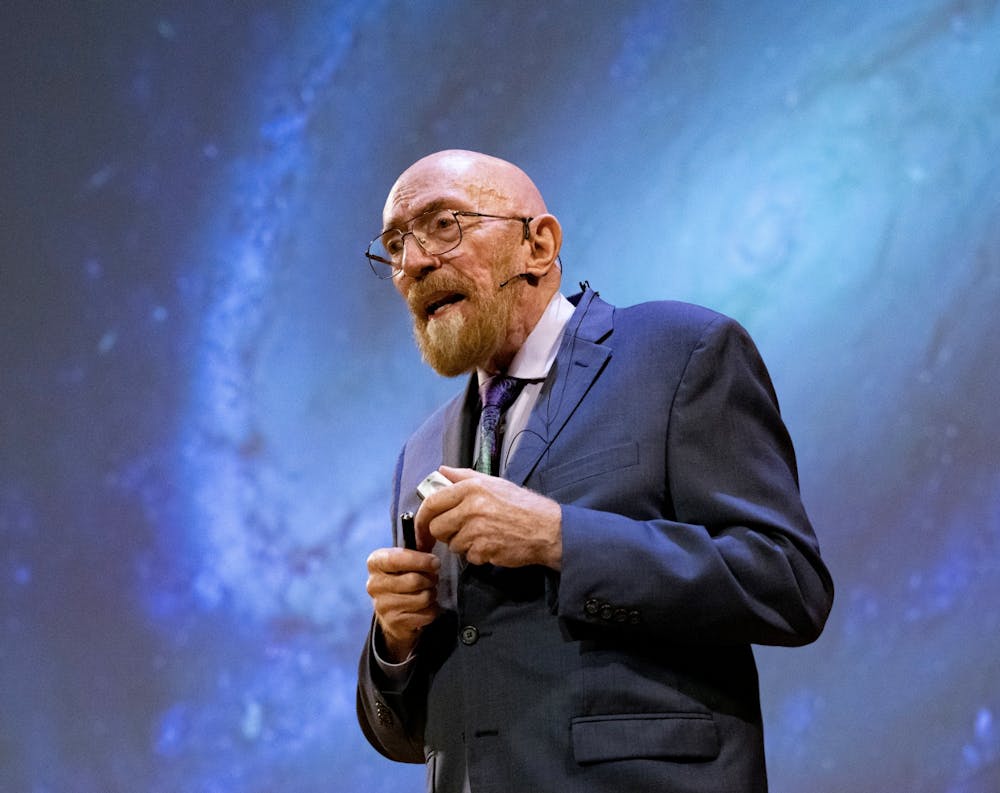Known for his contributions to gravitational physics and astrophysics, as well as his theory that space wormholes can be used for time travel, 2017 Nobel laureate Kip S. Thorne GS ’65, became the recipient of the University’s highest graduate alumni honor and delivered the James Madison Medal Lecture on Alumni Day 2020.
Established in 1973 and named after the University’s very first graduate alumnus, James Madison GS Class of 1771, by Association of Princeton Graduate Alumni (APGA), the James Madison Medal is awarded annually to an alumnus or alumna of the University Graduate School “who has had a distinguished career, advanced the cause of graduate education or achieved a record of outstanding public service.”
Previous recipients of the James Madison Medal include former University President Harold T. Shapiro GS ’64 (2004), experimental physicist and Nobel laureate John Bardeen GS ’36 (1973), retired U.S. Army General and former Central Intelligence Agency Director David H. Petraeus GS ’85 GS ’87 (2010), as well as numerous other prominent alumni of the graduate school.
Thorne lectured to a fully occupied first floor of the Richard Auditorium.
Thorne began his lecture, titled “Adventures in Inspiration: Exploring the Warped Side of Our Universe,” by remarking on the theme of “inspiration” that defined his career as a physicist.
“The most important thing I got from Princeton was inspiration, and the most important thing that I’ve given to the next generation is also inspiration,” Thorne said.
Thorne wasn’t always going to be a physicist. As a child growing up in Utah, he dreamed of becoming a snowplow driver. All that changed when his mother took Thorne to a geologist’s lecture on the solar system when he was eight years old.
In 1953, in a used book store in Salt Lake City, Thorne found a copy of “One, Two, Three, … , Infinity” by the physicist George Gamow, a book that inspired Thorne to become a theoretical physicist.

“I fell in love with those ideas and decided that I wanted to become a theoretical physicist working on relativity, and so here I am,” he said.
After graduating from the California Institute of Technology in 1962, Thorne arrived at the University as a graduate student, and researched under the mentorship of the Joseph Henry Professor of Physics, John Archibald Wheeler, who made great contributions to many aspects of 20th century physics including quantum information science, nuclear physics, and general relativity.
“John Wheeler was tremendously inspirational. I walked into his office at the Palmer Physical Laboratory [now Frist Campus Center] for the first time to meet him,” Thorne recounted. “He invited me in and gave me a personal 90-minute lecture about the collapse of heavy stars.”
The “collapse” would later become known as black holes, a name Wheeler is credited for popularizing.

Thorne remarked that at the time, Wheeler predicted that black holes were not likely to truly exist and instead reflected imperfections in the physical theories at the time, while wormholes, hypothetical structures connecting different points in spacetime, were more likely to exist. However, Thorne said, it turned out to be just the opposite: thousands of black holes have been detected, while no wormholes have ever been seen.
Thorne went on to recount the long story of the Laser Interferometer Gravitational-Wave Observatory (LIGO), an enormous physics experiment that successfully detected gravitational waves for the first time in September of 2015, which ultimately resulted in the awarding of the 2017 Nobel Prize in Physics to Thorne, Weiss, and Barry C. Barish, the Ronald and Maxine Linde Professor of Physics Emeritus, at Caltech.
LIGO was the largest project ever funded by the National Science Foundation (NSF) and represented the collaborative efforts of over a thousand scientists from 15 countries.
Thorne’s lecture, which took place 9 a.m. on Saturday, Feb. 22, concluded with a standing ovation. The presentation of the Woodrow Wilson Award took place shortly after the lecture.
Chair of the Department of Physics and the Class of 1909 Professor of Physics Herman L. Verlinde, who is a theoretical physicist studying the mathematical foundations of string theory and its applications to such things as black hole physics and quantum information theory, commented on the current excitements in the research of the physics Thorne spoke about.
“The merging of quantum mechanics and gravity is where all the questions are. We are currently still learning about what gravity really is, what spacetime really is,” said Verlinde. “When you put all these things together, it’s still a very interesting story that mashes together with even other modern ideas like quantum computing.”
University Vice President for the Princeton Plasma Physics Laboratory (PPPL) and Professor of Astrophysical Sciences David J. McComas drew connections between Thorne’s work on gravity physics and the research that currently takes place at the University’s PPPL.
“Generally speaking, I would say, there’s a lot of plasma physics in understanding how stars work, ultimately, we really try to understand the multi-messager response,” remarked McComas. “I don’t think people have gotten very far along in thinking that through; I think that’s another forefront that’s out in front of us.”








